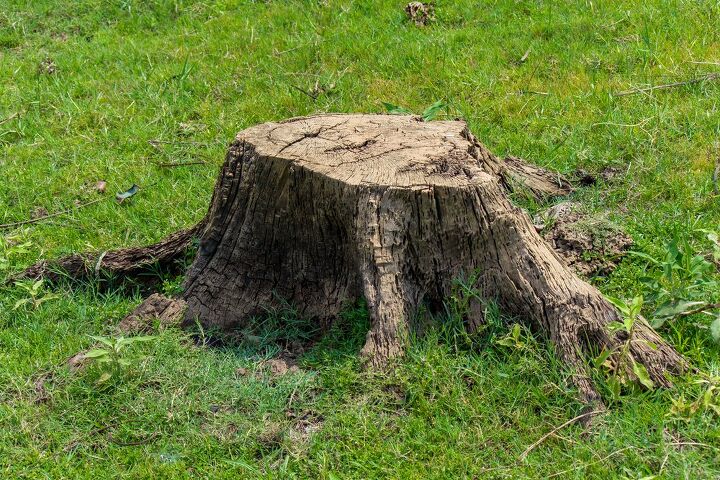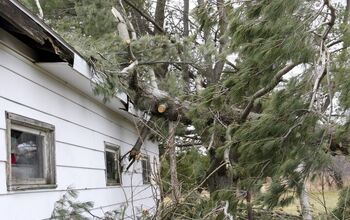What To Do With A Tree Stump In The Front Yard? (Do This!)

Tree stumps are a natural part of lawncare and gardening. I mean, trees don’t last forever. Eventually, you may have to cut down the tree standing in your backyard. When this happens, you’re going to be left with a massive (or not so massive) tree stump where the tree used to be. What do you do with this?
Tree stump removal is often the most HOA-approved way to handle a stump in your front yard. If you do not want to remove it, you can hide it through careful plant arrangement, use it as a table, or decorate it to add a focal point to a front yard garden.
There are a lot of ways that you can work with a tree stump. To make your options easier for you, we’re going to go through the basics.
Do You Need a Tree Service?
Get free, zero-commitment quotes from pro contractors near you.

Before You Begin: Check Your Local Codes
While I’m a huge fan of seeing whimsy in front yards, I’m also a realist. I know that a lot of parts of the country have local ordinances regarding tree stump cleanup and removal. Many regions will not allow you to keep a tree stump on your front yard, even if you have a nice setup. If this is the case, professional stump removal is your only choice.
If you have ordinances regarding this issue, you might want to get the removal done fast. Fines for a stump that is not removed can be as high as $300. Moreover, if you recently hired an arborist to remove your tree, call them up. They might also be obligated to remove the stump, too, depending on the local laws.
What Can You Do With A Tree Stump In Your Front Lawn?
Now that we have gotten into the main juice of the article, let’s talk about the many options people use when they want to deal with a tree stump.
1. Tree Stump Removal
Tree stump removal is exactly what you think it is. It’s the use of chemicals and physical force to kill the tree and remove the stump. In most cases, what happens is that people will chemically treat the stump to promote rot. Then, they will pull it out of the ground and dig it out. Then, the stump is taken into a wood chipper or sent elsewhere.
While you can do tree stump removal on your own, most people prefer to hire someone for this. It can get somewhat expensive for professional services, but it’s still worth it due to the labor cost. You should expect to pay between $60 to $400 for a tree stump removal.
2. Hide It
Another popular option that people can pursue is hiding the tree stump. This can be done by strategically planting flowers around the area. You can do this by choosing tall plants to surround the stump, then adding potted flowers on top of the stump.
We suggest some low-lying shrubs that have thick, evergreen foliage for the surrounding plants. If you want to add your own arrangement, make sure it’s taller than the stump itself, even during the winter. Otherwise, it might look a bit sparse. Grinding the stump as close to the ground as possible is important here.
3. Decorate It
Decorating a tree stump might seem like it’s counterintuitive, but it works. It’s all about knowing what you want out of your yard’s appearance. Decorating a tree stump can be done if it works with the right plan in mind. Some of the more popular ideas include:
- Using it as a base for a lamp or lantern. This adds a gorgeous touch of whimsy and can even help add ambient lighting. You can use the stump as a way to secure a lamp or a lantern’s base. This is ideal for people who have some form of electricity outside of their home.
- Place a mailbox there. A taller tree stump can even become a mailbox if you have the right equipment. You can either carve it out and add the federal box here, or you could place a mailbox on the top of the stump.
- Turn taller stumps into a bird bath. All you have to do is place the bird bath.
- Paint it. Painting a tree stump is a good idea if you like to keep things “hippie-friendly,” and want to keep the stump around. Artsy people can sand down the top of the stump then use waterproof paint to cover the stump with your own design.
- Turn it into a “fairy village.” This whimsical idea is popular among people who want to add a little magic to their front lawns. This involves placing cute miniature houses on top of the tree stump. In ideal situations, there might also be flower accessories.
4. Leave It Be
While it may not be the ideal route, some people prefer to keep the tree stump in its place. This is doable if you don’t have ordinances about it, but be careful. Leaving a tree stump be is something that you need to think twice about, simply because it carries some risk to it.
The most obvious issue is that people might end up tripping over the stump. That’s a lawsuit liability, sadly. However, there’s more to this issue than just that. Rotting tree stumps attract pests like termites and fleas. Moreover, they can also encourage certain diseases that take hold in local plantlife to spread.
5. Repurpose The Stump
This is a newer trend that has gained some traction among people who want to add a little rustic flair to a home. This requires you to remove the stump from your lawn. From there, builders tend to do the following:
- Sand down the base and top of the stump. This makes it possible for you to bring the stump indoors and nor have it be off-kilter.
- Treat the bottom and top of the stump. This should be done with some wood sealant or a finish. Some people are open to skipping this step, but I don’t suggest it.
- Add a tabletop. A lot of people tend to work with glass countertops, securing them with weights. However, you can also top the stump with iron.
Note: Please do not do this with a stump that already shows signs of rot or termite infestation. Using a rotten stump that has already been linked to critters, you might end up inviting pests into your home. That’s the rough part of sourcing stumps from the great outdoors.
How Deep Should Your Stump’s Removal Go?
If you want to remove a stump from your property, then you have to think about the depth of the removal. In most cases, you will be able to get rid of the stump at ground level and let it be. However, this means that the roots might still be left in your yard.
Keeping roots in your yard is rarely a good idea. Tripping over tree roots isn’t fun, and as the stump’s roots rot, critters can come by and make their home in your yard. If you want to remove the stump, make sure that you dig up the roots—at least to the point that they are no longer near 6 inches from the ground.
What Happens To The Stump After It’s Removed?
When a company removes your stump, they will usually put the stump in a wood chipper. This will turn the stump into mulch or wood chips for a playground. So, don’t worry. Your stump will find a way to remain useful and eco-friendly in the garden. In some cases, people might also use the wood chips for kindling or tinder.
In some cases, you can request to keep the stump. People who want to repurpose a stump should consider this if they want to turn their stump into a table indoors.
Do You Need a Tree Service?
Get free, zero-commitment quotes from pro contractors near you.

Related Questions
What are the best plants to help hide a tree stump?
Most people prefer to use climbing ivies (like English ivy), tall flowers (like daisies), and short shrubs. When choosing a plant to use as a shield or cover for your stump, you need to take the height of the stump into account. Shorter stumps can be totally covered with climbing ivies or creeping plants.
Can grass grow over a tree stump?
Grass might be resilient, but it still will not grow over the tree stump. Grass needs to have real soil underneath it in order to grow. This is one of the many reasons why HOAs do not want to see tree stumps on lawns. The large brown patch looks jarring on perfectly green lawns.
How do you cover up tree roots?
The easiest way to cover up tree roots is with a nice, thick layer of mulch that has a similar color. However, some people want to have a more plant-based cover. In this case, creeping ivy and regular English ivy can provide a beautiful color for roots that jut out.People who want to cover up roots in more imaginative ways can do so by adding decorative statues or “fairy homes.” Some have even used painted stones.

Ossiana Tepfenhart is an expert writer, focusing on interior design and general home tips. Writing is her life, and it's what she does best. Her interests include art and real estate investments.
More by Ossiana Tepfenhart



























